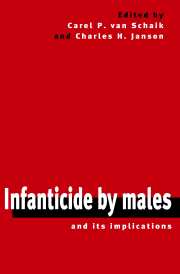Book contents
- Frontmatter
- Contents
- List of Contributors
- Foreword
- Infanticide by males: prospectus
- Part I Introduction
- Part II Infanticide by males: case studies
- Part III Behavioral consequences of infanticide by males
- 10 Prevention of infanticide: the perspective of infant primates
- 11 Infanticide and the evolution of male–female bonds in animals
- 12 The other side of the coin: infanticide and the evolution of affiliative male–infant interactions in Old World primates
- 13 Female dispersal and infanticide avoidance in primates
- 14 Reproductive patterns in eutherian mammals: adaptations against infanticide?
- 15 Paternity confusion and the ovarian cycles of female primates
- 16 Social evolution in primates: the relative roles of ecology and intersexual conflict
- Part IV Infanticide by females
- Part V Conclusion
- References
- Species index
- Subject index
12 - The other side of the coin: infanticide and the evolution of affiliative male–infant interactions in Old World primates
Published online by Cambridge University Press: 04 November 2009
- Frontmatter
- Contents
- List of Contributors
- Foreword
- Infanticide by males: prospectus
- Part I Introduction
- Part II Infanticide by males: case studies
- Part III Behavioral consequences of infanticide by males
- 10 Prevention of infanticide: the perspective of infant primates
- 11 Infanticide and the evolution of male–female bonds in animals
- 12 The other side of the coin: infanticide and the evolution of affiliative male–infant interactions in Old World primates
- 13 Female dispersal and infanticide avoidance in primates
- 14 Reproductive patterns in eutherian mammals: adaptations against infanticide?
- 15 Paternity confusion and the ovarian cycles of female primates
- 16 Social evolution in primates: the relative roles of ecology and intersexual conflict
- Part IV Infanticide by females
- Part V Conclusion
- References
- Species index
- Subject index
Summary
Introduction
In most species of the animal world, fathers contribute relatively little to the well-being and provisioning of their young, often no more than their genes (for exceptions, see, e.g., Ridley 1978; Trivers 1985; Clutton-Brock 1991). This is especially true for mammals, where internal fertilization, long gestation and lactation predispose mothers to care for their offspring alone. Since only females lactate, males can contribute relatively little to rearing of young. Due to internal fertilization paternity is never certain. Moreover, during the long periods of gestation males have ample time to desert the impregnated female in order to increase their reproductive success by seeking additional fertilizations with other females. Not surprisingly then, paternal care is found in only a small minority (less than 5%) of all mammalian species (Kleiman 1977; Clutton-Brock 1991; Woodroffe & Vincent 1994). Compared to most other mammalian taxa, however, primates are characterized by a surprisingly high level of male–infant affiliation or “male care”: Nearly 40% of all primate genera have been reported as exhibiting “direct male parental care” (carrying, retrieving, protecting, provisioning, grooming and/or huddling with young) – the highest percentage for any individual mammalian order (Kleiman & Malcolm 1981).
While there are reasons to remain skeptical about whether all of these observations are correctly classified as “male care” (e.g., Hrdy 1976; Packer 1980), or whether male care is really widespread among all of the species mentioned (Maestripieri 1998), this high level of male–infant affiliation is unexpected and, more importantly, does not seem to be well understood.
- Type
- Chapter
- Information
- Infanticide by Males and its Implications , pp. 269 - 292Publisher: Cambridge University PressPrint publication year: 2000
- 13
- Cited by

